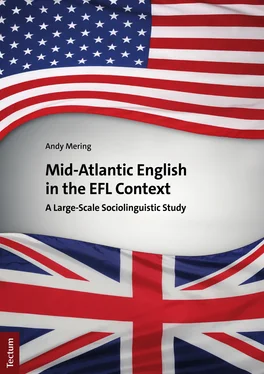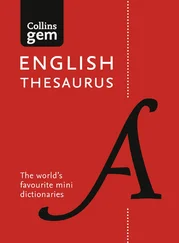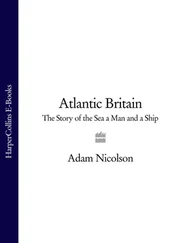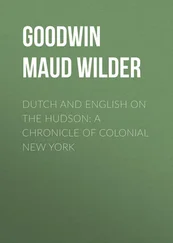In view of the foregoing considerations, the following sub-chapter delves deeper into this new perspective on EFL teaching: the interface between the concepts of Mid-Atlantic and Euro-English.
2.6.2 Mid-Atlantic English and Euro-English
2.6.2.1 Introduction
This section will provide a succinct overview of a complex emergent phenomenon in international settings labelled as Euro-English 9which, in Modiano’s view, will grow out of ‘MAE’, itself also a utopian ‘variety’. Other scholars commonly favour the term English as a Lingua Franca (henceforth abbreviated to ELF) (Jenkins, 2007; Modiano, 2009, p. 62) rather than English as an International Language (henceforth abbreviated to EIL) or Euro-English. All three terms refer to lingua franca uses of English primarily among the non-native speaker community with negligible differences in meaning. Jenkins sets out the reason why ‘ELF’ is the more widely used term in academia:
ELF emphasizes the role of English in communication between speakers from different L1s, i. e. the primary reason for learning English today; it suggests the idea of community as opposed to alienness; it emphasizes that people have something in common rather than their differences; it implies that ‘mixing’ [emphasis added] languages is acceptable … and thus there is nothing inherently wrong in retaining certain characteristics of the L1, such as accent, finally, the Latin name symbolically removes the ownership of English from the Anglos both to no one and, in effect, to everyone”. (Jenkins, 2000, p. 11)
This novel manifestation of ELF in its global uses will necessitate reappraisal of the sociolinguistic and pedagogical status of EFL. It will no longer support the singularity principle, in the guise of BrE, for example.
With respect to the mainstream definitions of the putative new ‘variety’ ELF, they are predicated on the premise of pluricentricity. This includes not only ESL and EFL but also ENL speakers. The proponents of an ELF conceptualisation in English Language Teaching (henceforth abbreviated to ELT) claim they do not take a ‘deficiency’ perspective akin to Quirk’s deficit linguistics ideology but a ‘difference’ one, avoiding such notions as native-like accuracy, (Harmer, 2007b, pp. 142–144; Legutke et al., 2009, p. 84; Lewis, 1993, pp. 52–54), failed native speakers, interference, fossilisation and so forth (Cook 1999, p. 196). Proponents of ELF seek to break away from notions of correctness. They are in favour of prioritising intelligibility, fostering innovation and promoting comity, i. e. building up friendly relationships with interlocutors from different L1 and cultural backgrounds (Jenkins, 2000, pp. 123–134; McKay, 2002, p. 75). Additionally, the concept of ELF also recognises the great significance of code-mixing and switching as bilingual resources, whereas traditional EFL views them as interference errors. Subscribers to the ELF concept also espouse the notions of co-constructiveness, listener-orientation, and non-normativity of prestige varieties.
In their view, the highlighting of these parameters for optimising mutual intelligibility among English speakers of different L1 backgrounds also presupposes the avoidance of “unilateral idiomaticity” (Seidlhofer, 2004, p. 220). This term coined by Seidlhofer refers to those situations in international encounters when one interlocutor uses an opaque idiomatic expression with which the other participant is likely to be unfamiliar. Therefore, in international forums for instance, it might be more appropriate to say “Can I help you?” instead of “Would you like me to give you a hand?” ELF endorsers consequently expostulate on a tradition-bound EFL pedagogy because in their view, it supposedly eradicates the criterion of learners’ NNS identity. They posit that EFL learners are fundamentally under the regime of the two main inner-circle varieties and therefore are expected to integrate into the BrE or AmE culture. ELF, to their way of thinking, is a constant identity negotiation process, fostering the maintenance of the NNS identities. In addition, the ELF concept no longer clings to the belief that a close approximation of an idealised NS accent is a precondition for becoming an international speaker of English (Jenkins, 2007, pp. 59–60, 81–92).
A useful definition of this new conceptual model of ELF 10can be found on the website of the Vienna-Oxford International Corpus of English (henceforth abbreviated to VOICE), whose founding and project director is Barbara Seidlhofer. VOICE captures spoken ELF interactions for purposes of research. Seidlhofer’s research area is lexis/lexico-grammar, of which she is in charge with her team. Their current research explores ELF features such as dropping the third person present tense, confusing the relative pronouns ‘who’ and ‘which’, the change of uncountable nouns to countable nouns (e. g. ‘furnitures’, ‘accommodations’, etc.), zero marking of the third person singular present tense, use of invariant question tags 11, insertion of redundant prepositions, e. g. discuss about, the use of the verb stem instead of the gerund in “I look forward to see [sic] you”, etc. (cf. Jenkins, 2003, p. 131).
Given the changing nature of English in the direction of a prospective lingua franca within the European Union (henceforth abbreviated to EU), it is essential to be cognisant of its linguistic landscape. In Europe, English exists alongside 23 other official languages but seems to be emerging as the most utilitarian European lingua franca. This potential lingua franca landscape of English is equated by Jenkins to Asian Englishes, which within the spirit of Kachru’s liberation linguistics had locally developed into endonormative second-language varieties (Jenkins, 2003, p. 38). However, the rather speculative assumption of Europeans moving towards their own potential distinctive putative ‘variety’ has lacked the empirical basis to date. The following section will therefore critically look into the notion of ‘variety’ to create a clear understanding of the current standard controversy in EFL teaching with regard to the label Euro English, which is inextricably linked to that of ‘MAE’ and ELF.
2.6.2.2 The Variety Status of Euro-English
In response to an obvious research need for the gauging of Euro-English variety status, Mollin suggested a catalogue of criteria to ascertain if “a potential independent variety of English in Europe” is emerging (2006, p. 5). She set out three requirements to determine the hypothetical variety status of Euro-English: expansion of function, nativisation of form, and institutionalisation of norms, i. e. the codification and official recognition of the new variety (2006, pp. 45–52).
In order to empirically determine whether a linguistic trend is a candidate for the emergence of a variety, Mollin drew up the following tripartite checklist, which I have adapted and abridged (cf. 2006, p. 52):
• Expansion in function
ο widespread societal bilingualism, i. e. use of speakers’ indigenous language(s) for local identity alongside their English
ο sociolinguistic analysis in several domains, i. e. education, administration, media, use of English for intranational and interpersonal communication, use in creative writing
• Nativisation of linguistic structures
ο tendency towards linguistic homogeneity in the speech community at the phonological, morphosyntactic, lexical and pragmatic level (i. e. the variety’s commonalities)
ο increasing spread of novel features into society
ο gradual development towards a local norm, e. g. the prospective consolidation of Euro-English as a distinctive variety
• Institutionalisation of a new standard
ο acceptance of the variety and its label, e. g. Euro-English, Mid-Atlantic English
Читать дальше












